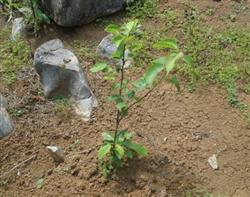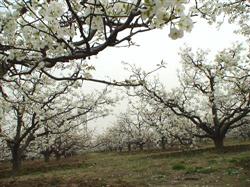How to fertilize and water pear trees?

How to fertilize and water pear trees? Please introduce the following methods for fertilizing and watering pear trees: first, fertilization technology 1, fertilizer application amount. Generally speaking, the production of 100kg pear fruit requires 0.47kg of pure nitrogen, 0.23kg of pure phosphorus, 0.48kg of pure potassium, and the ratio of nitrogen, phosphorus and potassium is 1pur0.5. If the yield of pears is 2500 kg per mu, 11.75kg of nitrogen, 5.75kg of phosphorus and 12kg of potassium are needed per mu. In actual production, the amount of fertilizer application can be calculated according to the content of effective components of various fertilizers. 2. Fertilization time. ⑴ was applied within 7-10 days after harvest to facilitate the recovery of tree potential, promote photosynthesis, increase nutrients and the occurrence of autumn roots, mainly available fertilizer. ⑵ applied base fertilizer from October to December, mainly organic fertilizer, accounting for 40-50% of the total fertilizer application in the whole year. It is very important to apply base fertilizer in autumn. Taking nitrogen fertilizer as an example, in the middle and later stage of pear fruit expansion, if too much nitrogen fertilizer is applied, the fruit shape is larger, but the fruit sugar content decreases, the flavor becomes lighter, and the disease is more serious, which does not meet the requirements of high-quality cultivation. The first ten days of June is the main period when the new leaves of pears begin to synthesize carbohydrates. the trees do not need too much nitrogen, but too little nitrogen is not conducive to flower bud differentiation and will affect flowering and fruiting in the second year. the best way to solve this contradiction is to apply more organic fertilizer in autumn and winter. ⑶ topdressing before and after anthesis promotes flowering and fruiting and branch and leaf growth. Available nitrogen fertilizer is the main topdressing before anthesis and phosphorus and potassium fertilizer is the main fertilizer after anthesis. During the fruit expansion stage of ⑷, nitrogen, phosphorus and potassium were applied in the fruit expansion stage of each variety. 3. The use of trace elements. Trace element deficiency is prone to element deficiency, which should be corrected in time. If iron deficiency is easy to cause yellow leaf disease, 0.5% ferrous sulfate can be sprayed 1-2 times a month in the growing season, and yellow leaves can be turned green after repeated spraying, and a certain amount of ferrous sulfate can also be applied in spring. Zinc deficiency can easily cause lobular disease. 4-5% zinc sulfate solution can be sprayed before germination and 0.3-0.5% zinc sulfate solution can be sprayed after germination. In addition, spraying 0.2-0.5% boric acid solution during or after anthesis can not only treat boron deficiency, but also improve fruit setting rate. For young pear trees, because the root system of young pear trees is underdeveloped, fertilization should be based on the principle of thin fertilizer to avoid burning seedlings. At the same time, increase the phosphorus and potassium fertilizer to enhance the tree potential. Second, water management should be based on soil water status and water requirement of pear trees to determine irrigation time and amount of irrigation. Pear trees need more water before and after germination, during the period of young fruit expansion after flowering, during the middle and later period of fruit growth, after fruit harvest and before defoliation, among which the period of young fruit expansion after anthesis is the critical period of water demand of pear trees, which is the most important. Timely irrigation can promote the growth of new shoots and leaves, expand the assimilation area, enhance photosynthesis, increase fruit setting rate and increase fruit, and play a good role in flower bud differentiation in the later stage. For young pear trees, because they are sensitive to changes in the natural environment and are prone to drought and waterlogging, they should often loosen the soil and water to preserve soil moisture during drought. Click for more pear tree planting techniques click to get more fruit planting techniques
- Prev

How to plant pear trees?
How to plant pear trees? Please introduce in detail that the pear tree has strong adaptability to the natural environment, strong resistance to waterlogging and stress, and can be planted in mountainous and flat land. Pollination trees are needed when planting. For example, yellow flowers match the new century or Hangqing. 1. Pear trees are generally planted from late November to January next year, and should not exceed early spring at the latest.
- Next

How should pear tree planting be managed in spring?
How should pear tree planting be managed in spring? Please give guidance pear planting spring can refer to the following methods for management: First, strengthen fertilizer management 1, apply good bud fertilizer: after the Spring Festival, adult pear trees, each tree special fertilizer 1.5 kg, 2003 along the mountain ecological construction planting young trees each tree supplement fertilizer.
Related
- Moge, come on! The staff of the peasant association in the producing area of cantaloupe were frightened when the crowd gathered.
- Causes and Solutions of low Fruit setting rate of Apple
- Symptoms and control measures of passion fruit virus disease
- Fruit growing lesson: how do apple orchards keep high yields?
- Can you build orchards in the mountains? What are the pros and cons?
- How to manage the coloring period of Crisson grape?
- This paper introduces the processing technology of two kinds of fig products.
- How much is a month for retired teachers in rural areas by 2020?
- How can strawberry planting increase sugar content? We should pay attention to management in many aspects.
- What are the cultivation techniques on how to improve the yield of golden fruit?

